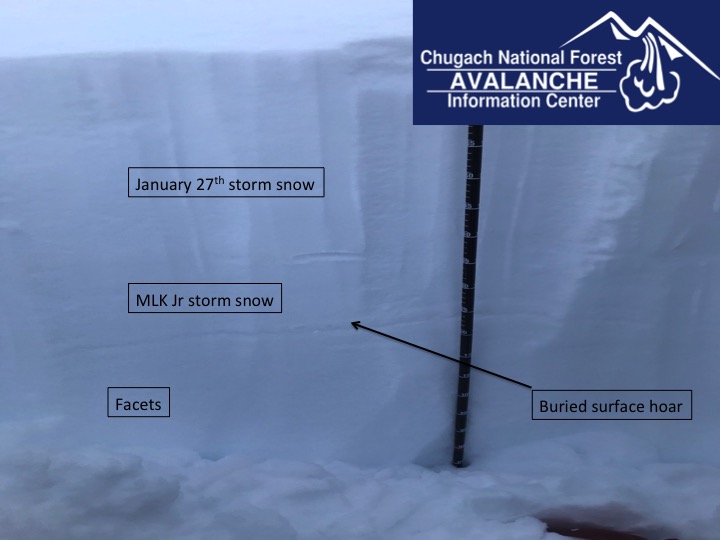New snow is so exciting but the snowpack needs time to adjust to the snow load. There are now three storms worth of snow sitting on the weak snow (facets and surface hoar) that formed over the long stretch of cold and clear weather. With the previous storms that buried the weak snow, the snow had not formed a slab and the snow was enjoyed without incident. Yesterday there were some storm ingredients that may have changed all that and increased the likelihood of triggering a large avalanche. Because of the additional snow, warming temperatures and sustained strong winds, 2-3′ thick slabs now sit over the buried weak layers just waiting for a trigger. This set-up must be guilty until proven innocent. Be on the lookout for signs of instability today. Have there been recent avalanches? There were some naturals observed yesterday. Are there shooting cracks from your skis or machine? An observer yesterday noted cracks shooting out 3 ft. Can you feel collapsing? Does the snow feel grabby or punchy (a sign of heavier snow over soft snow)? Can you see drifting and cornices? Is the snow wind effected? Slabs over facets and buried surface hoar also have the potential to be triggered remotely. What slopes are you traveling on and under? If you or your party gets stuck in the snow in avalanche terrain, don’t send another to dig out. The message today is choose your travel route carefully and be conservative. Don’t let the powder cloud your judgement! Today could be a good day to check out the snow at Alyeska or enjoy the powder in the Placer or Turnagain flats!
Loose snow avalanches: Observers yesterday noted deep snow, getting stuck and overall slow going. In areas where the snow remains protected and soft, loose snow avalanches are possible in steep terrain. These could be quite hazardous in terrain traps. Even a small avalanche could bury you deeply.

The snowpack at 2500′ on Tincan, 1.28.20. There is now another 1-2′ of snow on top of the buried weak layers. This is the concern today.

A closer look at the buried surface hoar. This delicate weak layer has the potential to be triggered and cause a large, dangerous avalanche today.

Powder cloud from a natural avalanche observed at 2 pm yesterday from the Johnson Pass South trailhead. Recent avalanches are an indication that the snowpack is unstable. 1.29.20. Photo: Alex McLain



